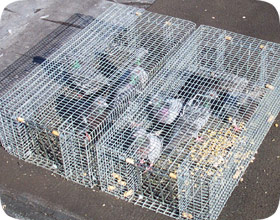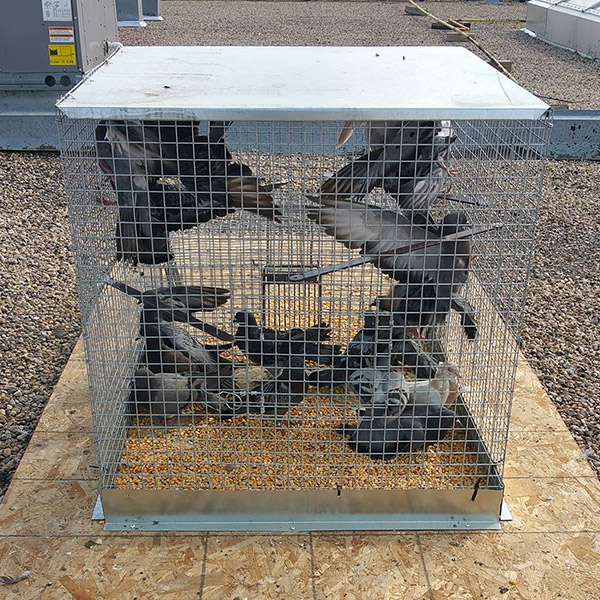-
info@aaanimalcontrol.com
Call us for help in your town
Humane Wildlife Education
Tips on Trapping Pigeons In Cages
Need pigeon removal in your hometown? We service over 500 USA locations! Click here to hire us in your town and check prices - updated for year 2020.
The best means of pigeon control is usually the installation of deterrent devices, such as needle strips, shock track, or netting, to prevent them from roosting on undesirable areas. However, in some cases, you simply need to
lower the pigeon population in a given area. In this case, you can catch pigeons in special cage traps, designed to catch multiple pigeons.
The key to pigeon trapping lies in pre-baiting. Pigeons can be wary and suspicious, but if you wire the cage doors open, and bait with corn, and the pigeons can come and go freely, eating the corn, they gain trust in the
trap. Then you set it, and catch the pigeons.

In fact, once you catch the first pigeon in the cage, others tend to copy, and you can catch many. But what do you do with the pigeons after you trap them? Well, you certainly can't relocate them elsewhere! As you know, pigeons can find their
way home from thousands of miles away, in just a couple days! So you have to euthanize them. Some people use a C02 chamber, some wring their neck.
Need pigeon removal in your hometown? Click here for my nationwide list of bird removal experts, serving
hundreds of cities in all 50 states! In the event that you wish to hire a bird removal company, you may want to see how much does bird removal cost?

Pigeons are the one of the most annoying species that we can find in the cities, and their number is only getting larger by years. They are a messy, disease-carrying pests and many people literally hate them and want to remove them from their lives. There are several different ways how to successfully trap the pigeon and you can find about them in the text below.
You can catch a pigeon with the classic, old-fashioned trap. You could make one yourself or purchase it. There are many different varieties of traps, but basically, it is the large cage with the one-way entrance. If you want to catch more than one pigeon, you need to buy an appropriate sized trap. Choose a spot where the pigeons are frequently situated. Set the trap and put some seeds, corn or nuts or whatever you have inside the cage because the pigeons are well-known omnivorous and they will eat pretty much anything. You can leave the food around the cage, as well and put the big portion inside. Leave the door open for the couple of days to give the pigeons sense of security and to feel that they can return to the spot whenever they’re hungry because there is a free food. After the first pigeon came in, the others will follow very quickly. Do not use any poison with the bait because another animal can get to it, or a house pet, if you have one. Try to capture the pigeon on a most humane way possible.
The fact is that you will catch the pigeon eventually. They are maybe smart birds, but there are a lot of them and they’re always hungry, so it would not be a tough task to manage. What is the next step after capturing the bird? First, remember that the pigeons are disease carriers, so make sure that you have minimum contact with them, wear thick gloves and thick clothes in order to prevent any possible contamination. The laws about the pigeons are not the same in every country, some of them are suggesting a humane euthanasia, others have special sites where you can release the pigeons, but given that the pigeons are very clever and they know how to get back home, you better take prevention steps in case they came back to your property.
The other solution is the simplest one we could come with. Remember the cartoons and the scenes in which the characters are catching a bird with the paper box, stick, string, and bait? It actually works! Just be sure that the box is not too light because it will allow the pigeon to get away quickly. It’s the cheapest way in catching the pigeon and all you need to do is to be patient. It will take some time, but it will occur, eventually. Just, take a good hiding spot, the long string will do the trick and after a while, the pigeon will notice free food and it will get into the trap. At that very moment, you need to pull the string strong and quick, and that’s it. You’ve got yourself a pigeon.
One of the interesting ways in trapping the pigeon is the mouse glue. First, you have to dilute the glue because it is very strong and can harm a bird. After that, choose the location where you want to put some seeds to attract the pigeons and then set up the glue around that site. It is crucial to check the place on every 10 minutes or so because the poor bird can have a serious problem with a glue all over it and could die very fast, especially if the glue gets to the wings. When you trapped a pigeon, you have to clean it properly and decide your next step, whether to release the bird somewhere or to take it to the pest controllers. This kind of trapping the birds is forbidden in some countries because people used a pure, non-diluted mouse glue and in time when they get to the site, the birds are already dead and some of them were protected and endangered species. Otherwise, it is a very effective way to catch the birds. You just need to check the trap every now and then and to free the bird as soon as possible. The natural way of making the glue which will not harm the pigeons is of the mistletoe berries.


















